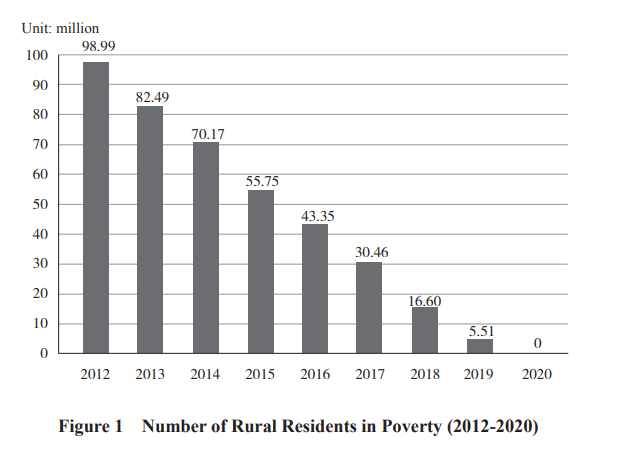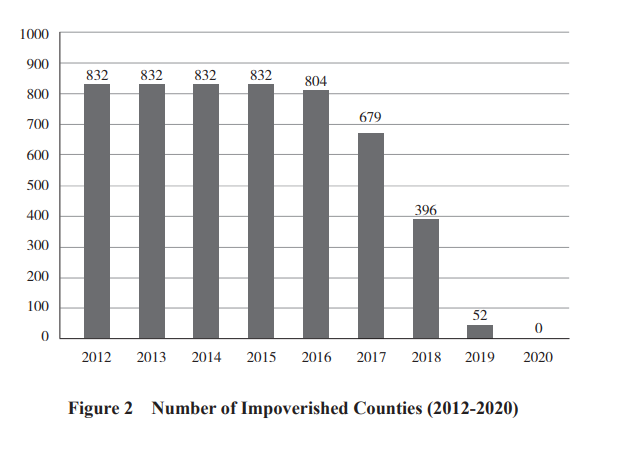

China's fight against poverty entered a critical stage after the 18th CPC National Congress in 2012. At the end of 2020, through eight years of hard work, China achieved the goal of eliminating extreme poverty – a key goal for the new era of building socialism with Chinese characteristics. The 98.99 million people in rural areas who were living below the current poverty threshold all shook off poverty (Figure 1); all the 128,000 impoverished villages and 832 designated poor counties got rid of poverty (Figure 2). China has eliminated poverty over entire regions and eradicated extreme poverty.
The battle against poverty has been another great revolution in rural China, leading to historic and comprehensive changes. The campaign saw an end to the backwardness of poverty-stricken areas, boosted overall rural development, resolved the greatest threat to success in achieving moderate prosperity in all respects, and laid a solid foundation for building a modern socialist China and realizing the Second Centenary Goal. China has secured a complete victory in the battle against extreme poverty, eliminating overall and extreme poverty for the first time in its history of thousands of years, and realizing a century-long aspiration of the Chinese people.


1. Significant Improvement in the Living Standards of the Poor
Through poverty alleviation, there has been a substantial improvement in the incomes and welfare of the poor. The fight against poverty has led to dramatic changes in the lives of the impoverished.
The incomes of the impoverished are increasing (Figure 3). The per capita disposable income of the rural poor increased from RMB6,079 in 2013 to RMB12,588 in 2020, up by 11.6% per annum on average. The growth rate was 2.3 percentage points higher than the national rural average. Their salary income and operative income kept increasing over the years in proportion to their transfer income, showing a stronger ability to shake off poverty through their own efforts.
Ethnic minority areas have made notable progress in fighting poverty. From 2016 to 2020, in the five autonomous regions (Inner Mongolia, Guangxi, Tibet, Ningxia and Xinjiang) and three provinces with a large multi-ethnic population (Guizhou, Yunnan and Qinghai), the number of the poor dropped by 15.6 million. Extreme poverty was eliminated in all 28 of the minority ethnic groups with a small population.
Poor households now have adequate food and clothing all year round and a proper supply of nutritious food. They have clothing for all four seasons and comforters that protect them from cold weather.
Access to good quality education for the impoverished has improved remarkably; there are no dropouts in the countryside due to financial difficulties; nine-year compulsory education is now available to all children from rural poor households, and the completion rate in 2020 was 94.8%.
The three-tier healthcare system at village, township and county levels has been improved. Basic medical insurance coverage of the poor is now over 99.9%. The program of safe drinking water for rural residents has secured supplies to 28.89 million poor in terms of both quantity and quality, and benefited 382 million rural population; tap water coverage increased from 70% in 2015 to 83% in 2020.
2. Poverty-stricken Areas Rid of Backwardness
Poor areas have long suffered from weak infrastructure, inadequate public services, and social and economic underdevelopment. In the final stages of fighting poverty, China succeeded in raising all the rural poor out of extreme poverty and the impoverished areas achieved a big stride in economic and social development, taking on a brand new look.
Infrastructure has been improved. By the end of 2020, impoverished areas had gained 1.1 million km of reconstructed highways and 35,000 km of new railways; all the villages, townships and towns in poverty-stricken areas with the right conditions were accessible by paved road and provided with bus and mail routes, which facilitated more economic development.
Water infrastructure in impoverished areas has been improved in many ways. Since 2016, the effective irrigated area has increased by more than 5.35 million ha and water supply capacity has increased by 18.1 billion cu. m.
Electricity access in poor areas has been improved through power grid construction projects such as power supply to areas without electricity, upgrading of rural power grids, and construction of trunk power grids and power transmission channels.
Communications infrastructure has been extended in poverty-stricken areas. Now, over 98% of poor villages have access to optical fiber communications (OFC) and 4G technology; distance education is available at more schools in impoverished areas; telemedicine and e-commerce cover all designated poor counties.
Basic public services have been improved. In addition to providing adequate food, clothing and safe housing for the impoverished, China has intensified efforts to improve basic public services covering education, healthcare, culture and social security.
Since 2013, China has renovated 108,000 schools to strengthen the provision of compulsory education in poor areas, and ensured that all school-age rural children receive kindergarten and elementary education within their own villages.
Public cultural services in poor areas have also been improved. By the end of 2020, 99.48% of villages in 22 provinces and equivalent administrative units in central and western China had seen their own cultural centers completed. The campaign of bringing culture to the countryside has enriched the cultural life of the rural poor.
There has been a notable improvement in healthcare provision in poor areas. 98% of the designated poor counties now have at least one grade-two hospital. The county-level hospitals in impoverished areas can treat 90% of the diseases that general county-level hospitals can.
Comprehensive social security systems are now in place in poor areas. The standards of eligibility for rural subsistence allowances in designated poor counties are all higher than the national poverty threshold.
Some 19.36 million impoverished people have been covered by rural subsistence allowances or extreme poverty relief funds, and 60.98 million by basic pension schemes for rural and non-working urban residents, achieving nearly 100% coverage.
Poverty-stricken areas have seen notable improvements in their economic structure.
The GDP of impoverished areas has maintained rapid growth. Since 2015, the average annual increment in per capita revenue from the national general public budget has been seven percentage points higher than the national average. A steady increase in incomes has created higher demand for life quality and cultural activities. This has stimulated a surge in consumption in rural areas, and provided support for the domestic economy.
Cultural heritage has been protected. The eco-environment has improved. China has integrated development-driven poverty alleviation with soil and water conservation and eco-environmental conservation. Through the fight against poverty, China has increased the incomes of the impoverished, improved the eco-environment of poor areas, and made the vast rural areas more livable spaces for their inhabitants.
3. Those Who Have Been Lifted Out of Poverty Adopt a New Mindset
The battle against poverty is a profound revolution and complete victory on both material and theoretical level. Through this battle, the mindset of the poor has been enriched and sublimed – they have greater confidence, more active minds, and higher aspirations; they have experienced a thorough transformation from the inside to the outside.
The impoverished have a deep desire to rid themselves of the shackles of poverty and achieve prosperity. The battle against poverty has opened the door to the outside world for poverty-stricken areas. Cultural and ethical work has been advancing in impoverished regions. Scientific, healthy and civilized new ways of life which are simple, green, eco-friendly, and hygienic have been embraced by the villagers.
4. Protecting the Rights of Special Groups to Basic Needs and Development
China prioritizes the basic rights of subsistence and development of the disadvantaged groups among women, children, the elderly, and the disabled. The nation has enacted favorable policies and provided more assistance to raise the welfare level of these groups.
Living conditions of impoverished women have been improving. China adheres to the fundamental national policy of gender equality, and sees women as a key target in poverty alleviation. Among nearly 100 million who have shaken off poverty, women account for half. By implementing the Outline of Women's Development in China (2011-2020), China has given priority to helping women alleviate poverty and reducing the number of women in poverty, given preferential treatment to women when making poverty alleviation policies, allocated funds and taken measures, and helped them solve the most difficult, most worrying and most pressing problems. A total of 10.21 million impoverished women have received skills training, over 5 million of whom have increased their incomes through activities such as handicrafts, crop and animal husbandry, housekeeping and e-business. Small-sum guaranteed loans and micro credit amounting to more than RMB450 billion have been provided to impoverished women, which have helped 8.7 million women to start businesses and increase their incomes. China has assisted 192,000 women who suffer from poverty and diseases and launched a program of free cervical and breast cancer checkups to cover all women in poverty-stricken areas. RMB4.17 billion has been invested in titled campaigns to provide 50 million impoverished mothers in impoverished areas with infrastructure and health benefits, as well as daily necessities.
Extending greater care to deprived children. China has implemented the Outline on the Development of Chinese Children (2011-2020) and the National Development Plan for Children in Poor Areas (2014-2020) to provide security for children's education and health and deliver interventions when required. Efforts have been made to popularize knowledge on children's nutrition and health. Following the implementation of nutritional improvement projects for children in impoverished areas, children in these regions now enjoy better health. The government gives a free daily pack of nutritional dietary supplements to every baby and toddler aged 6-24 months in contiguous destitute areas. By the end of 2020, a total of 11.2 million children in those areas had benefitted from this project. Birth defect prevention & relief programs have been launched to help cover medical expenses for children who suffer from poverty and serious diseases such as congenital malformations, some inherited metabolic disorders, and thalassemia. A total of RMB470 million has been allocated for the care of 41,000 sick children. China has organized volunteers to pair up with orphans, deprived children, and children of migrant workers left at home in the countryside, providing care and help to 25.19 million children and parents. More than 280,000 children's homes and over 1,200 children's happy homes have been built to give entertainment, psychological counseling, life care and tutoring to deprived children and children of migrant workers left at home in the countryside. China continues to improve the protection of orphans' rights and interests, with monthly allowance for orphans in welfare institutions and families that provide temporary care totaling RMB1,611 and RMB1,184 per person respectively. China has invested RMB1.7 billion in the Tomorrow Plan for Rehabilitation of Handicapped Orphans to offer operations and rehabilitation to 223,000 orphans with disabilities. RMB540 million from the public welfare has been used to carry out a program to support school education for 54,000 orphans. A support system for de facto orphans has been established in China to cover 253,000 such children.
Continuing to provide services and improve the lives of impoverished senior citizens. China has raised the amount of basic pension in rural areas and subsidies for basic medical insurance for poor seniors to further reduce poverty among the elderly in rural areas. The subsidy system for the poor population of advanced age and incapacitated seniors has been put in place, benefiting 36.89 million people. On the basis of an overall inspection, China has verified 627,000 impoverished seniors who lost the ability to take care of themselves and extended contracted family doctor services to 590,000 of them, significantly improving their health.
Strengthening the protection of impoverished people with disabilities in an all-round way. More than 7 million poor people with disabilities have been lifted out of poverty as scheduled. The systems for providing living allowances for poor people with disabilities and nursing subsidies for severely disabled persons cover more than 24 million. China includes 10.67 million people with disabilities in the system of subsistence allowances. Poor people with disabilities are now all covered by basic medical insurance and serious illness insurance. Among them, 547,000 people have received medical assistance. China has made efforts to ensure 1.79 million poor households with one or more disabled members live in secure housing. The special needs of impoverished people with disabilities are being met. More than 80,000 disadvantaged children with disabilities have received generally beneficiary pre-school education. The houses of 653,000 impoverished households with severely disabled members have been upgraded for better accessibility. New progress has been made in nursing care for poor and severely disabled people.
5. Significantly Improving Grassroots Social Governance in Poverty-stricken Areas
The fight against poverty is a successful exercise in the modernization of China's system and capacity for governance. Our success in this battle has improved our poverty governance, and significantly improved China's systems and capacity for grassroots social governance in impoverished areas.
The public are becoming increasingly active and are breaking new ground in grassroots governance. At the beginning of poverty alleviation, many poor villages had little collective income. By the end of 2020, the average collective income in impoverished villages across the country had exceeded RMB120,000. With a steady collective income, many village organizations have become more capable of keeping operations running and serving the people.
Increasing the number of rural service personnel who have a good knowledge of agriculture, love our rural areas, and care about rural people. Since 2013, more than 3 million first Party secretaries and resident working team members have been selected and dispatched to carry out targeted poverty alleviation. Notable progress made in strengthening China's capacity for social governance. Our complete victory over extreme poverty is an outstanding achievement in the history of both China and humanity.
Source:<www.scio.gov.cn/zfbps/32832/Document/1666228/1666228.htm>